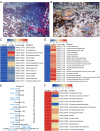Characterization of the first cultured free-living representative of Candidatus Izemoplasma uncovers its unique biology
- PMID: 33746205
- PMCID: PMC8397711
- DOI: 10.1038/s41396-021-00961-7
Characterization of the first cultured free-living representative of Candidatus Izemoplasma uncovers its unique biology
Abstract
Candidatus Izemoplasma, an intermediate in the reductive evolution from Firmicutes to Mollicutes, was proposed to represent a novel class of free-living wall-less bacteria within the phylum Tenericutes. Unfortunately, the paucity of pure cultures has limited further insights into their physiological and metabolic features as well as ecological roles. Here, we report the first successful isolation of an Izemoplasma representative from the deep-sea methane seep, strain zrk13, using a DNA degradation-driven method given Izemoplasma's prominent DNA-degradation potentials. We further present a detailed description of the physiological, genomic and metabolic traits of the novel strain, which allows for the first time the reconstruction of the metabolic potential and lifestyle of a member of the tentatively defined Candidatus Izemoplasma. On the basis of the description of strain zrk13, the novel species and genus Xianfuyuplasma coldseepsis is proposed. Using a combined biochemical and transcriptomic method, we further show the supplement of organic matter, thiosulfate or bacterial genomic DNA could evidently promote the growth of strain zrk13. In particular, strain zrk13 could degrade and utilize the extracellular DNA for growth in both laboraterial and deep-sea conditions. Moreover, the predicted genes determining DNA-degradation broadly distribute in the genomes of other Izemoplasma members. Given that extracellular DNA is a particularly crucial phosphorus as well as nitrogen and carbon source for microorganisms in the seafloor, Izemoplasma bacteria are thought to be important contributors to the biogeochemical cycling in the deep ocean.
© 2021. The Author(s).
Conflict of interest statement
The authors declare no competing interests.
Figures






References
-
- Hug LA, Baker BJ, Anantharaman K, Brown CT, Probst AJ, Castelle CJ, et al. A new view of the tree of life. Nat Microbiol. 2016;1. - PubMed
Publication types
MeSH terms
LinkOut - more resources
Full Text Sources
Other Literature Sources

